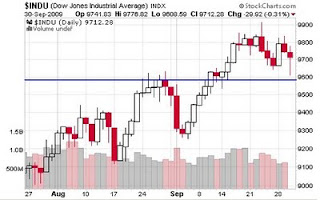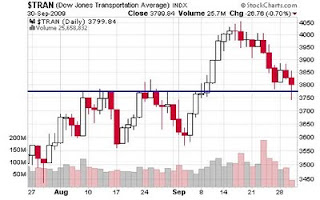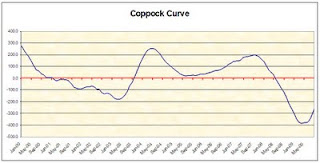Dow Theory is a fickle beast. While the theory is sound, those that interpret it have their challenges. A recent article dated May 21, 2015 titled “Transportation Average – A Big Concern for Stock Bulls?” by Chris Ciovacco presents some of the difficulties with the topic of Dow Theory. In this article, we’ll attempt to clarify some issues that should be discussed when making interpretations of Dow Theory.
The article by Ciovacco starts off by pointing out the recent divergence between the Dow Jones Transportation Average and the Dow Jones Industrial Average. A divergence exists when one index makes new highs or lows while the other index fails to go in the same direction. According to Dow Theory, if there is a divergence, it could indicate that the previous trend will be reversed. As the prior trend in the stock market from 2009 to 2015 has been bullish, the implication is that the bull market could be coming to an end.

In explaining whether investors should be worried about the “non-confirmation” exhibited by the divergence between the Industrial and Transportation Averages, the article identifies the period from 1989 to 1993 when there appeared to be a divergence between the same indexes. However, at the time of the divergence, according to the author, the S&P 500 managed to gain as much as +25%. What is not shown or discussed are the key indications of a bull or bear market in the period from 1989 to 1993. These elements will complete a picture that is necessary for anyone hoping to understand and possibly benefit from Dow Theory.
Identifying the Bear Market
Below is a charting of the period 1989 to 1993 in smaller segments for a more accurate Dow Theory assessment. First is the indication of a bear market based on Dow Theory which occurred on October 13, 1989.

Our ex post interpretation of when a bear market was signaled by Dow Theory is supported by the Dow Theorist Richard Russell in his Dow Theory Letters publication. In his official investment stance on October 4, 1989, Russell said:

This is contrasted by what Russell said in his October 18, 1989 posting:

Russell made clear that from a Dow Theory perspective, a bear market had been signaled. As a side note, Russell’s PTI or Primary Trend Indicator did not confirm the bearish signal until February 7, 1990 (four months later). The PTI is not a part of Dow Theory but has proven to be a useful market tool.
Identifying the Bull Market
Using our own ex post analysis of the charts of the Dow Jones Industrial Average and the Dow Jones Transportation Average, we find that a new Dow Theory bull market was signaled on January 18, 1991.

Richard Russell was suspicious of the Dow Theory bull market that was signaled on January 18, 1991 and chose to wait for his PTI to give the all clear. Russell said the following on February 6, 1991:

But even the preceding commentary was buried by the following overriding thoughts by Russell:

The question is ultimately asked by Ciovacco, “Would it have made sense to sell all our stocks because the Dow Transports failed to make a new high?” The point being, why get caught up in a “signal” that potentially will result in lost investment gains? After all, the S&P 500 index increased by +25% in the period when it appeared that there was a divergence between the Dow Jones Industrial Average and Dow Jones Transportation Average.
This is where a significant problem comes up in the analysis of Dow Theory. First, if we assume that a divergence did occur in Ciovacco’s selected time frame, rather than a bear market indication, then an adherent of Dow Theory would accept that a divergence is merely a caution signal. This would have meant that whatever the previous trend of the market was, it remains in place until a definitive reversal occurs. In our most recent market action, a bull market was still the indication and thus there would be no need “… to sell all our stocks…”
Another issue not mentioned is that Dow Theory does not give buy or sell signals as we pointed out in our July 25, 2011 article. Among the many things overlooked about Dow Theory is that it is intended to reflect the changes in the stock market, investment values, and the economy. As a barometer, it merely indicates the direction that the stock market and economy might go three to nine months into the future. Those who take bull or bear market indications as buy or sell signals still need to be well versed in understanding values and compounding and their role in investing. If a person, not versed in values and compounding, believes that any indication means that they can haphazardly buy or sell stocks then they are most likely to suffer severe losses and quickly become disenchanted with the accumulation of assets.
Identifying Recessions
In the past, Dow Theory was often heralded as a peek into the future for the economy. In the 1989 example above, the Dow Theory bear market preceded the National Bureau of Economic Research’s (NBER) definition of a recession by nine months. Dow Theory signaled a bear market in October 1989 and the NBER indicated that a recession began July 1990. However, the NBER announced their conclusion about when the recession began on April 25, 1991, a full year and a half after the Dow Theory bear market signal and nine months after their own designation of when the recession began. Additionally, Dow Theory indicated that a new bull market was in place on January 18, 1991 or three months before the NBER announced that the recession ended in March 1991.
Final Thoughts
What some market bears would like to accomplish with Dow Theory is to anticipate scenarios where divergence leads to an actual bear market of significant magnitude like what happened in the period from 1972 to 1974.

The decline experienced from the respective peaks was –59% and –44% for the Transports and Industrials. Since the outcome of a divergence cannot be accurately anticipated, it is far “safer” to wait for the confirmation of the trend before considering any potential actions. However, if investors had sold their stocks on October 13, 1989 and repurchased stocks on January 18, 1991 (and held until December 31, 1993), the gains would have been +40%, +41% and +76.04% for the S&P 500, Industrials and Transportation Index, respectively.
What some market bulls would like to accomplish without Dow Theory is not selling if the net effect is for the market to ultimately climb well beyond the point of the initial divergence. As an example, if we take the October 13, 1989 date and calculate the returns for the S&P 500, Dow Industrials and Dow Transports until December 31, 1993, we find that the returns were +39%, +46% and +25%, respectively.
Dow Theory only works as a barometer for the stock market when taken in the context of investment values and compounding. As an indicator of coming recessions, as defined by NBER, Dow Theory has an unrivaled track record. The translation of these ideas often get confused as recessions don’t necessarily result in jarring –50% declines in the stock market every time.
Our tactic on the divergence is to dump more funds into the cash portion of the brokerage account so that we can make large purchases if a precipitous decline ensues. If a decline does not materialize, we will continue our slow and selective investment buying program for compounding purposes.

















